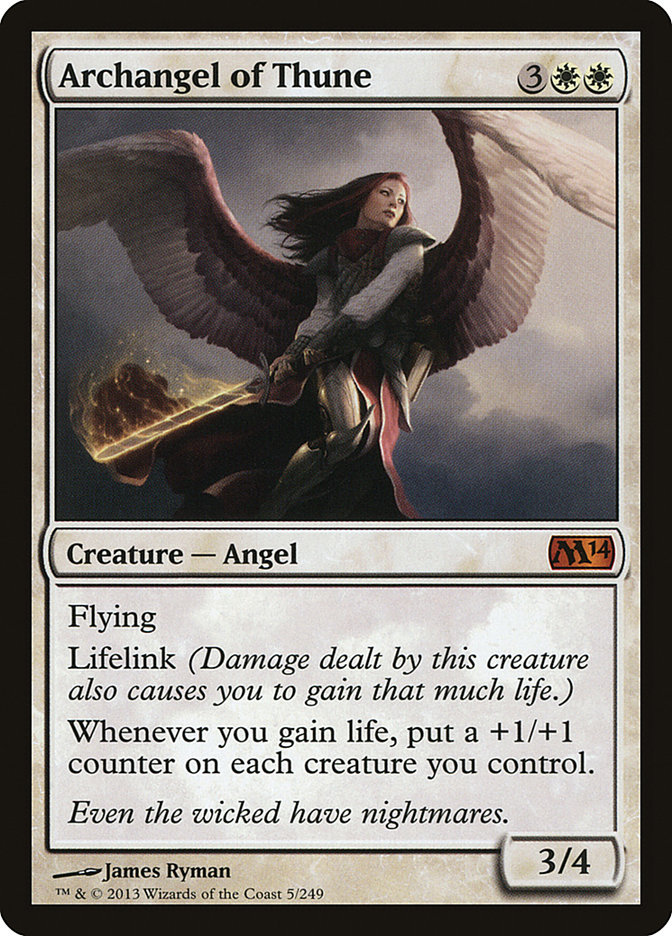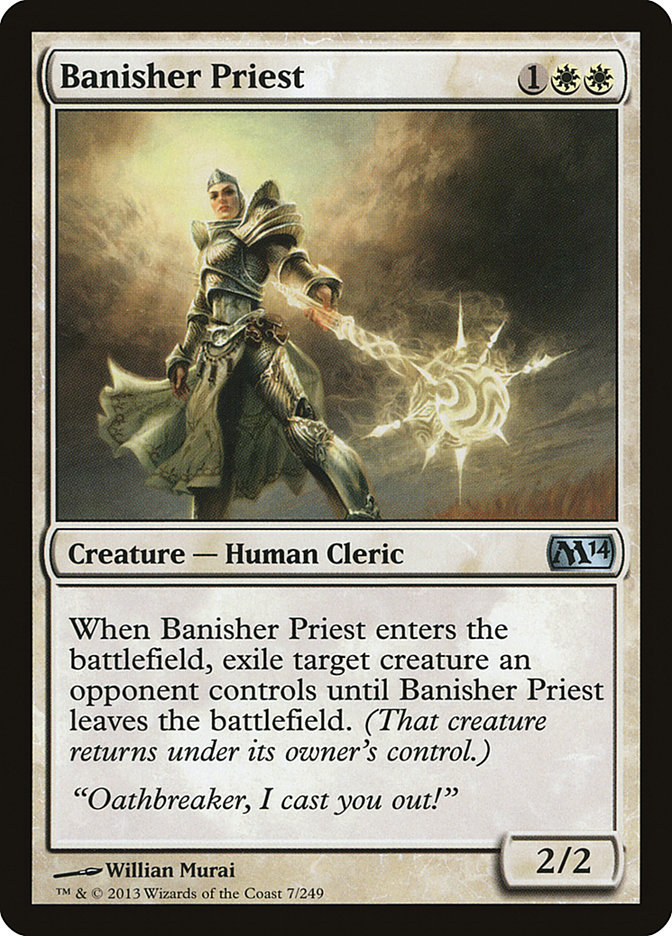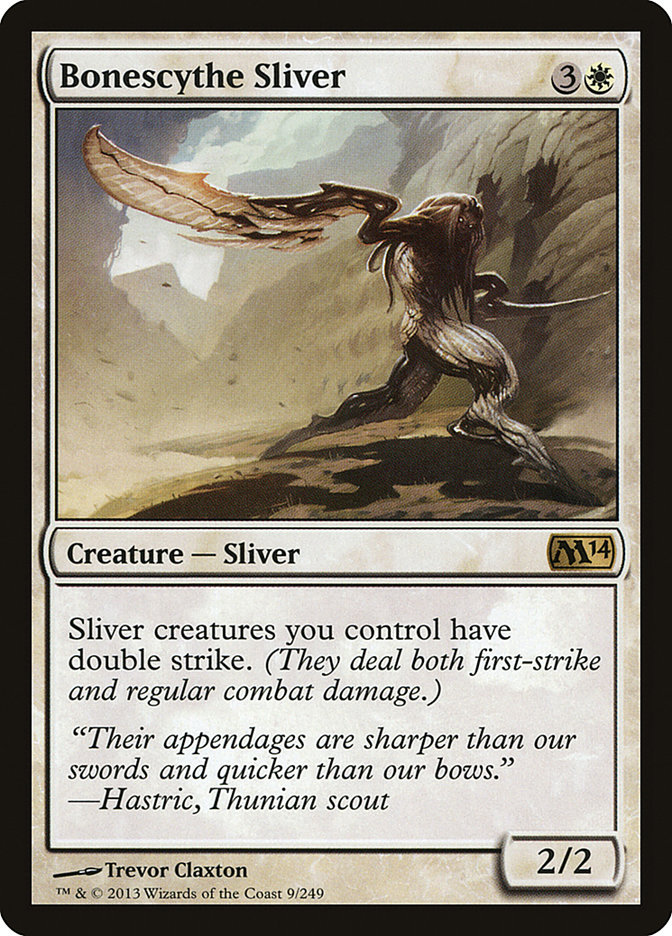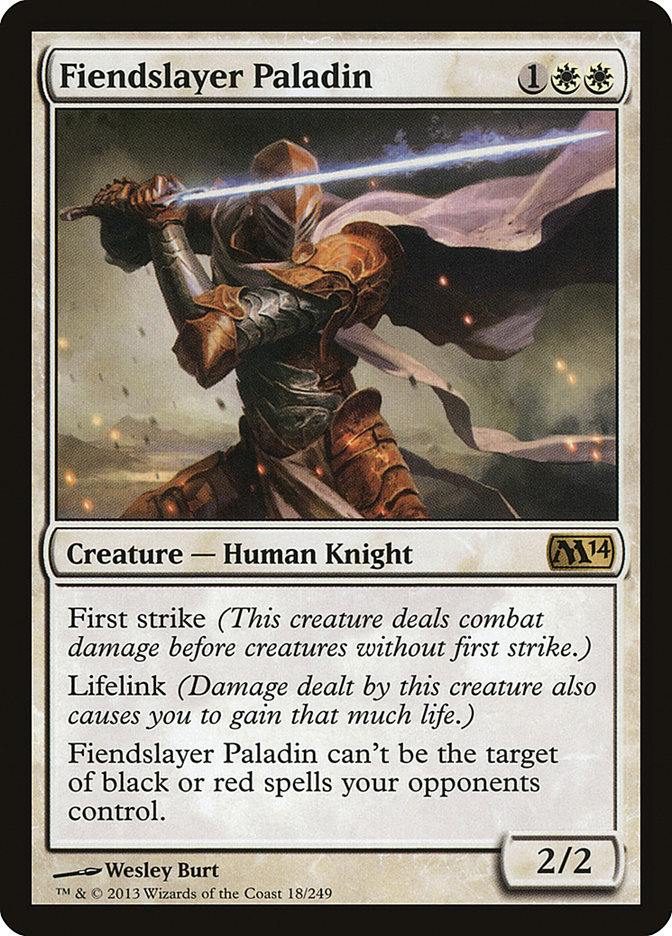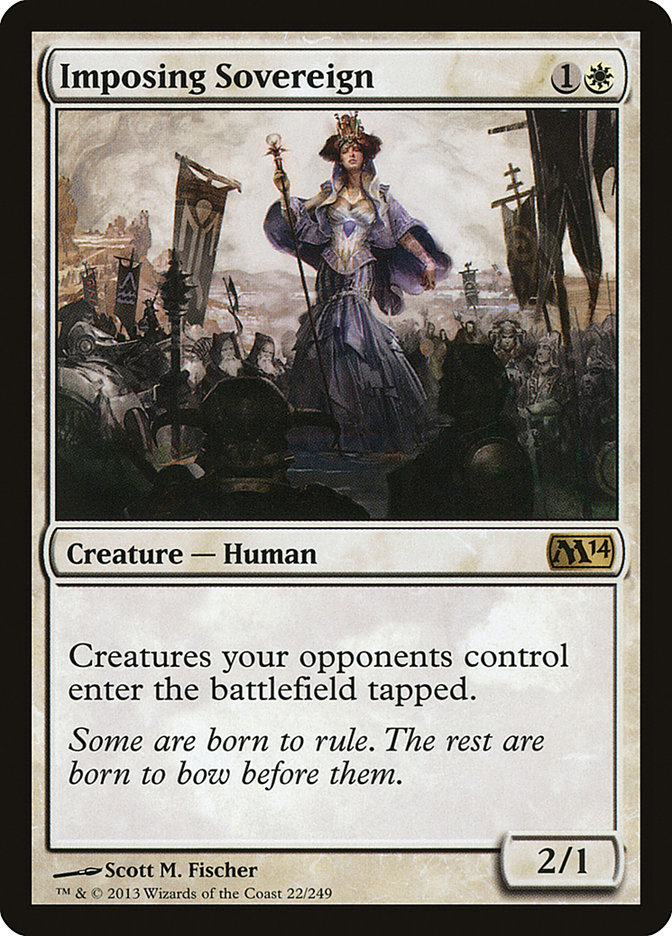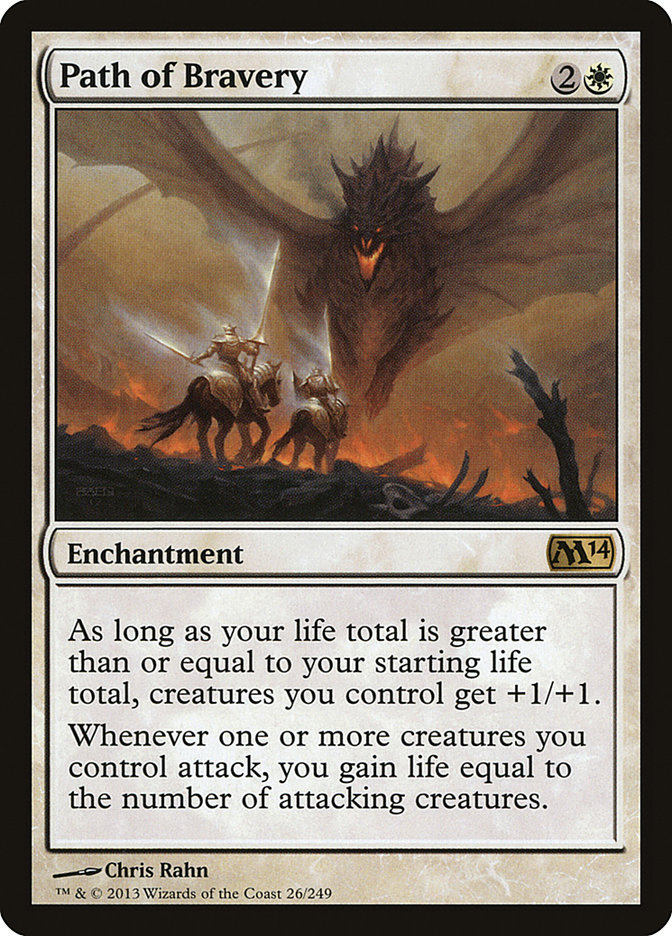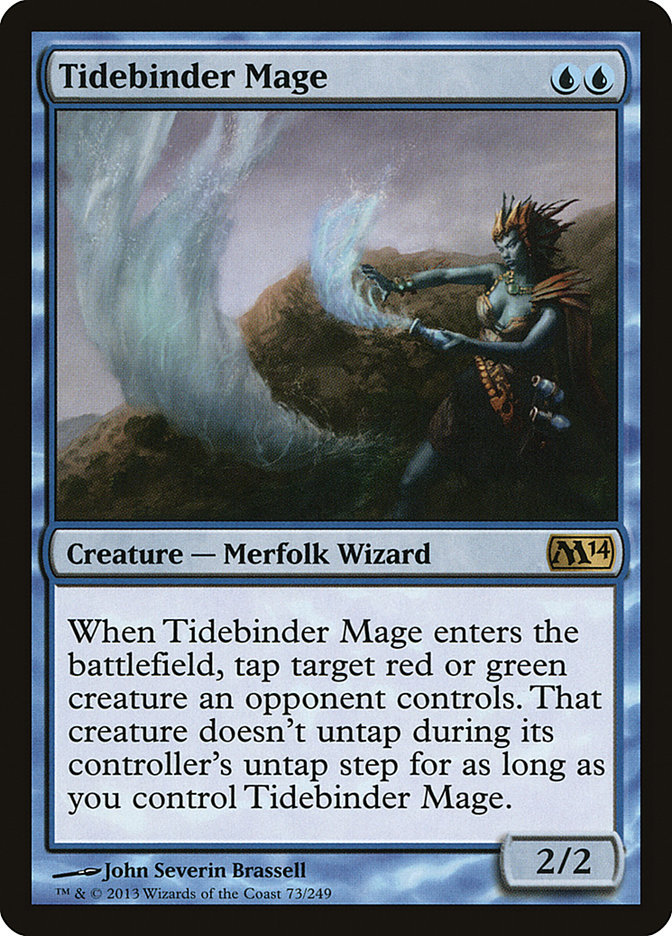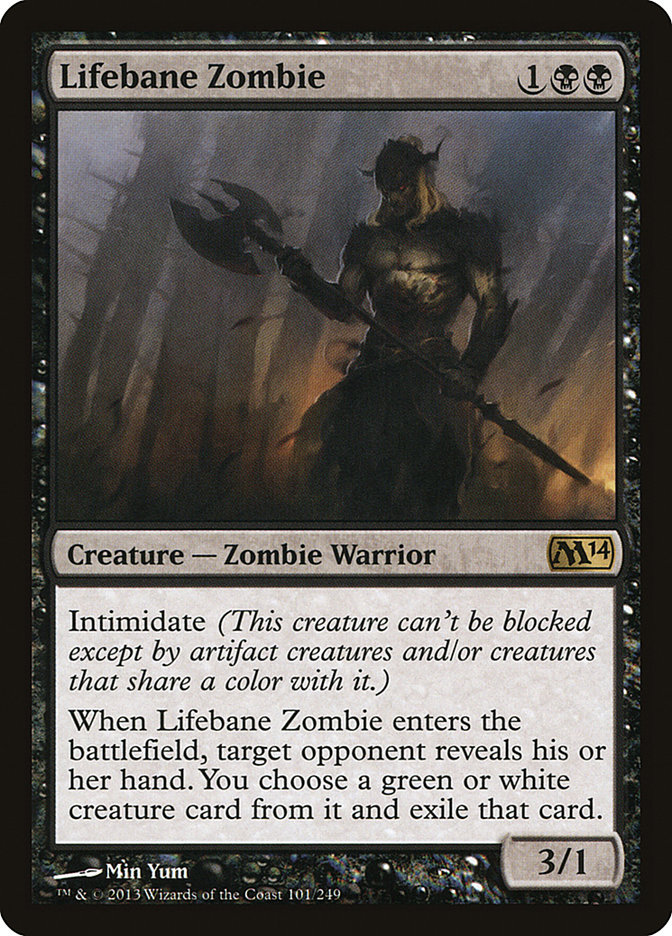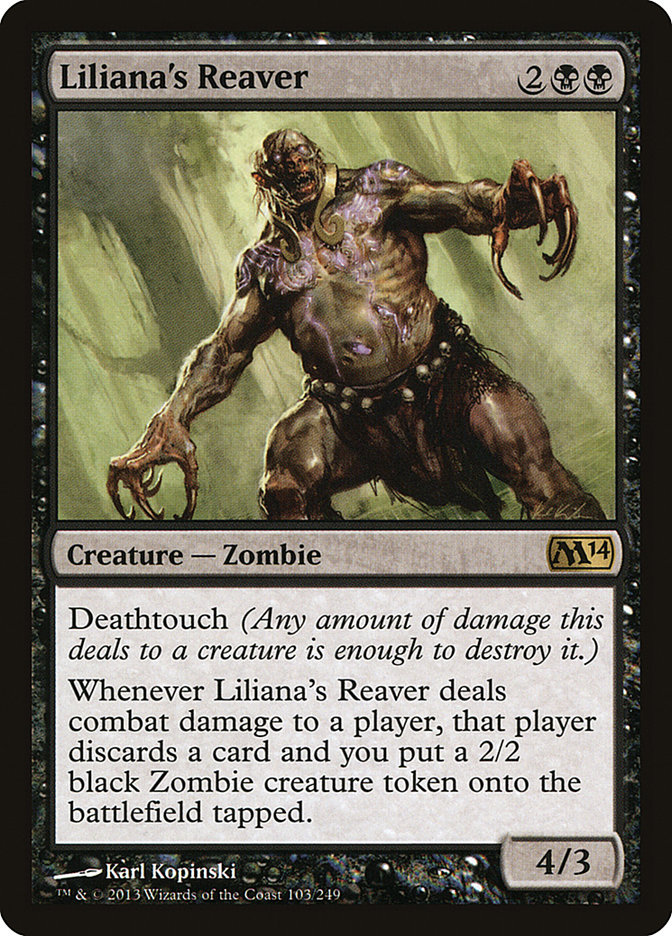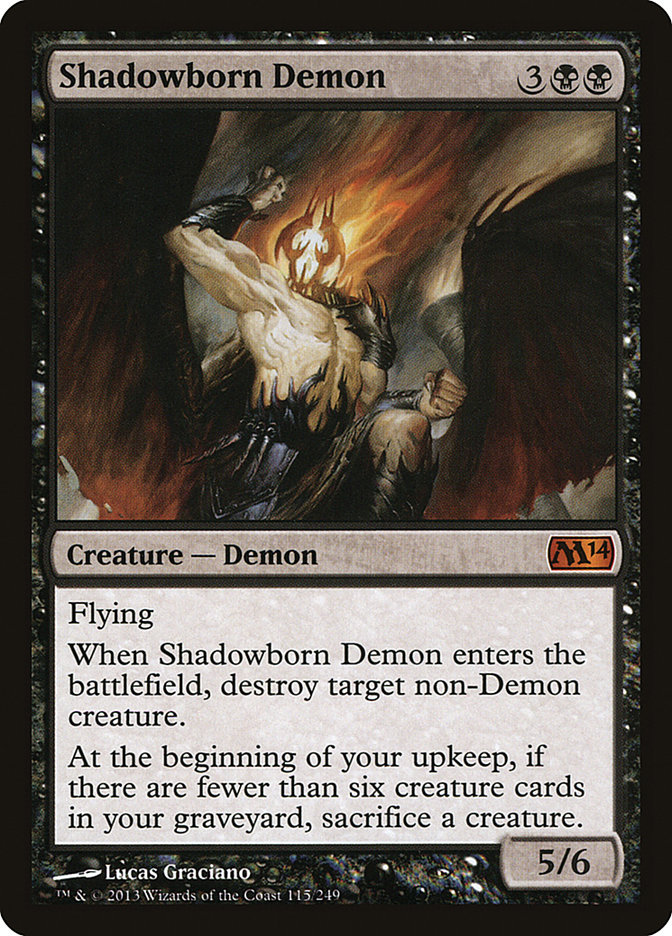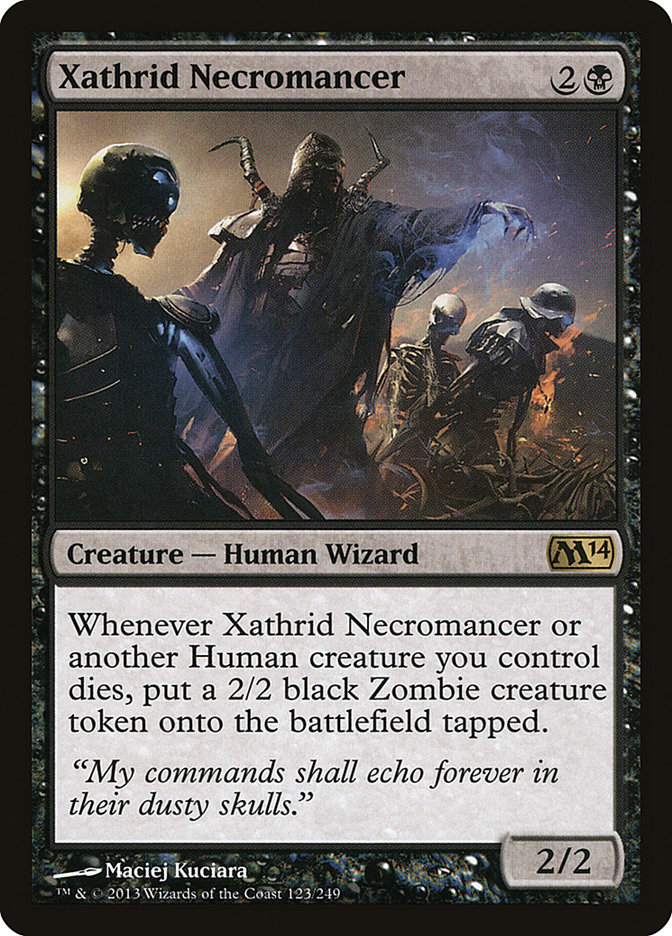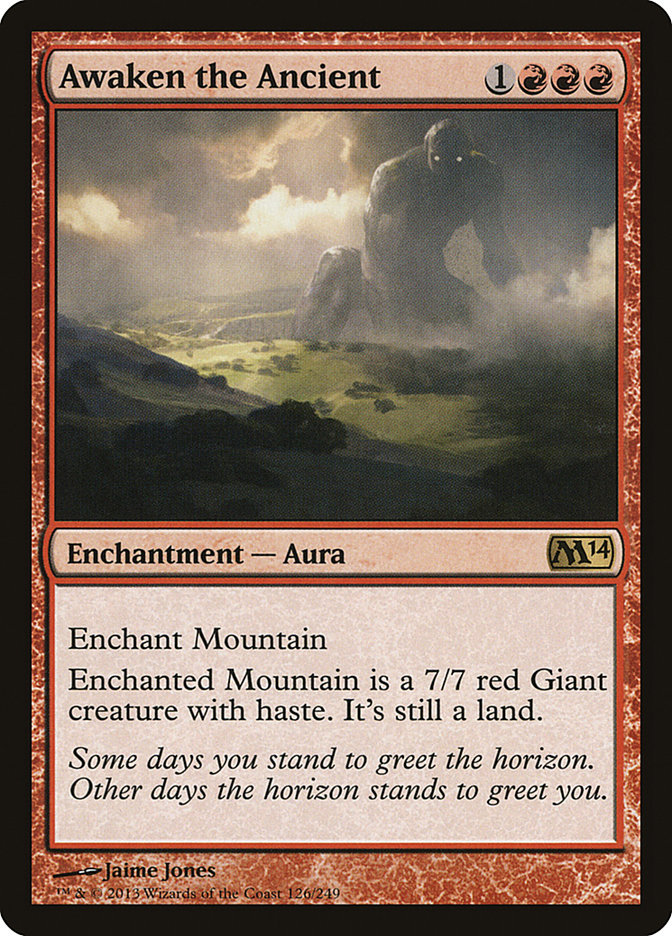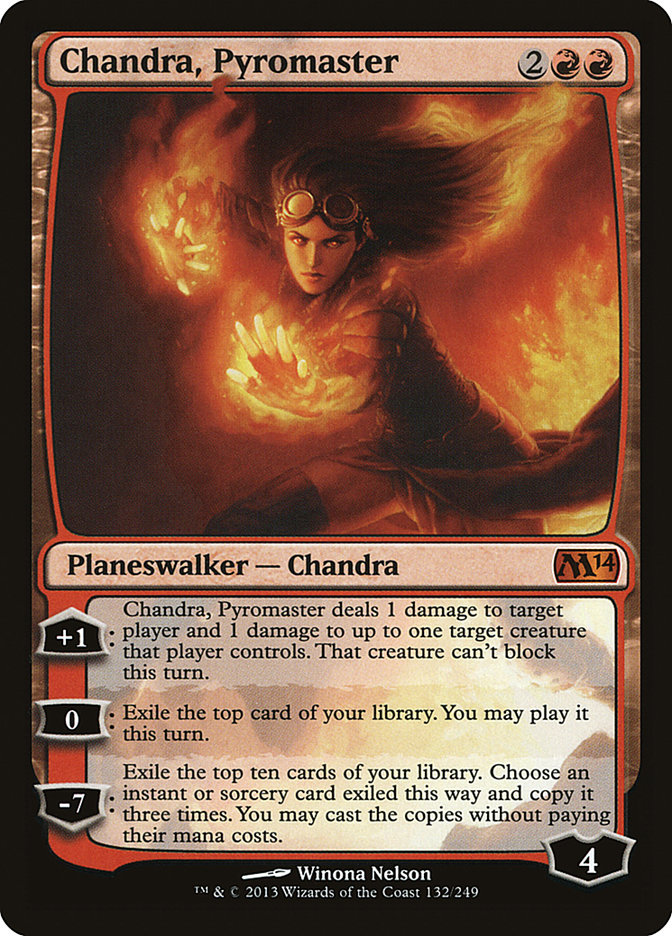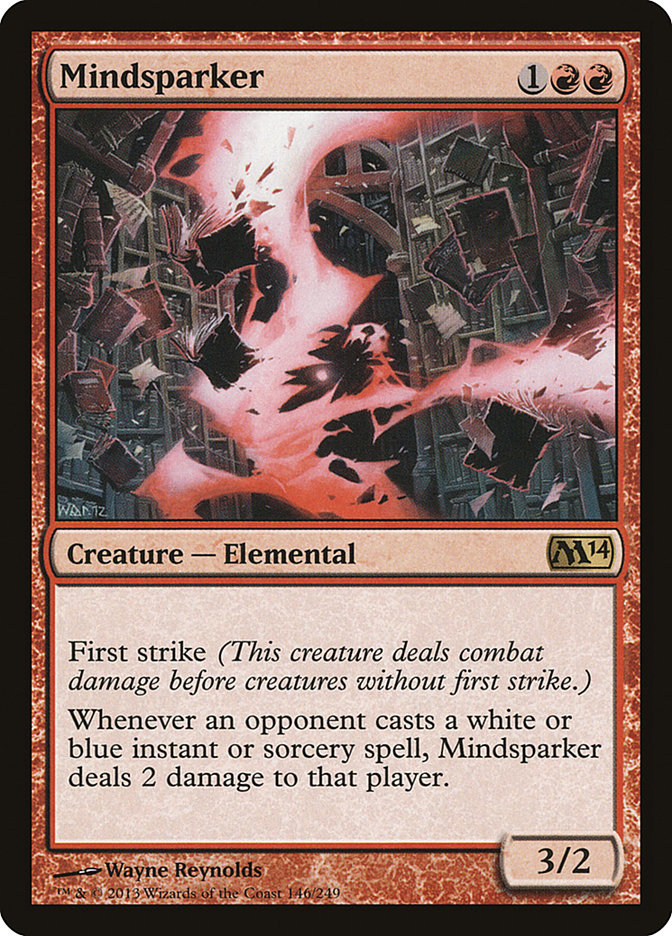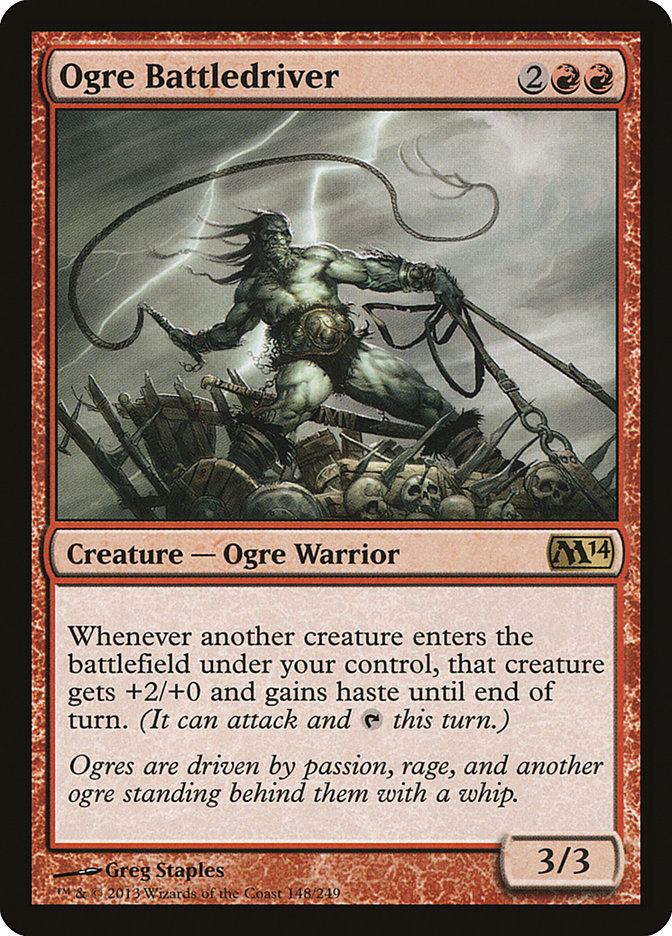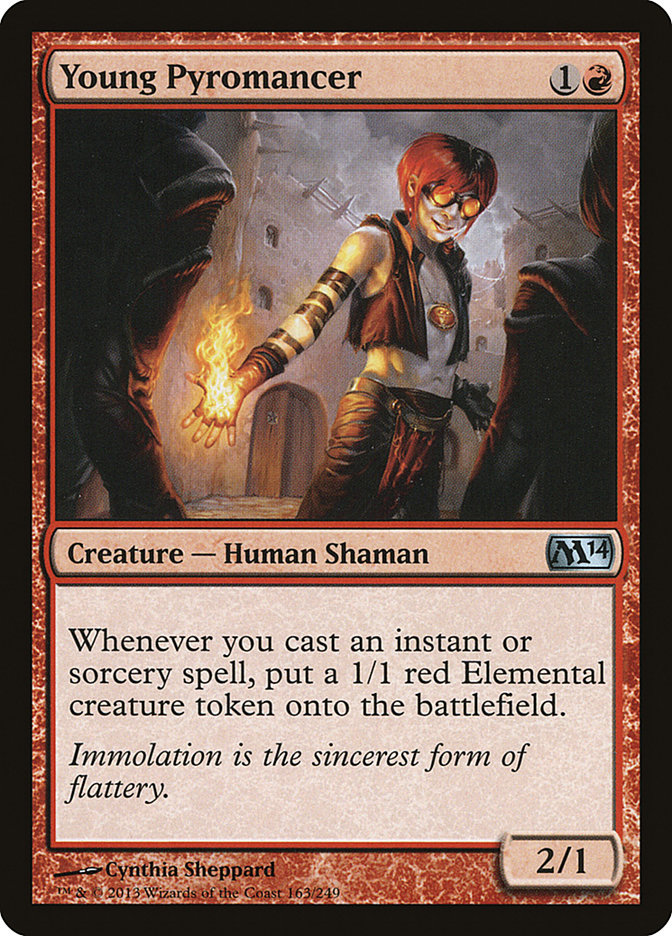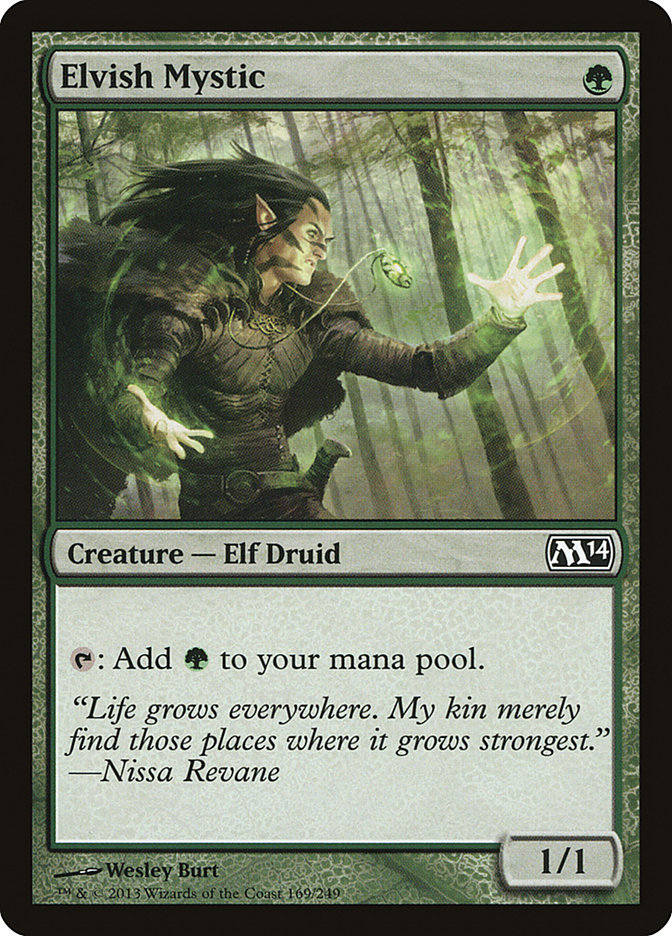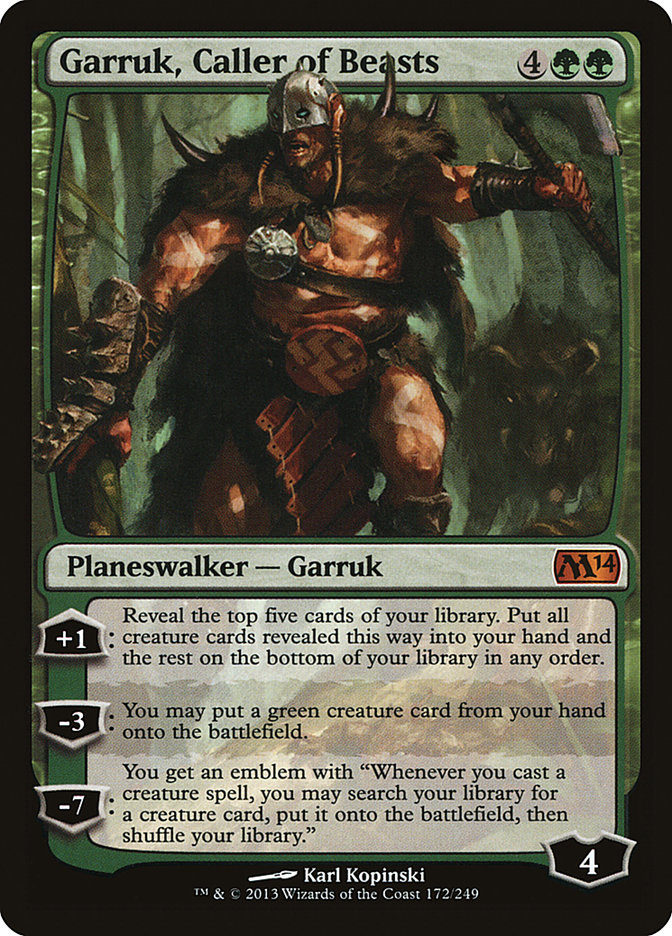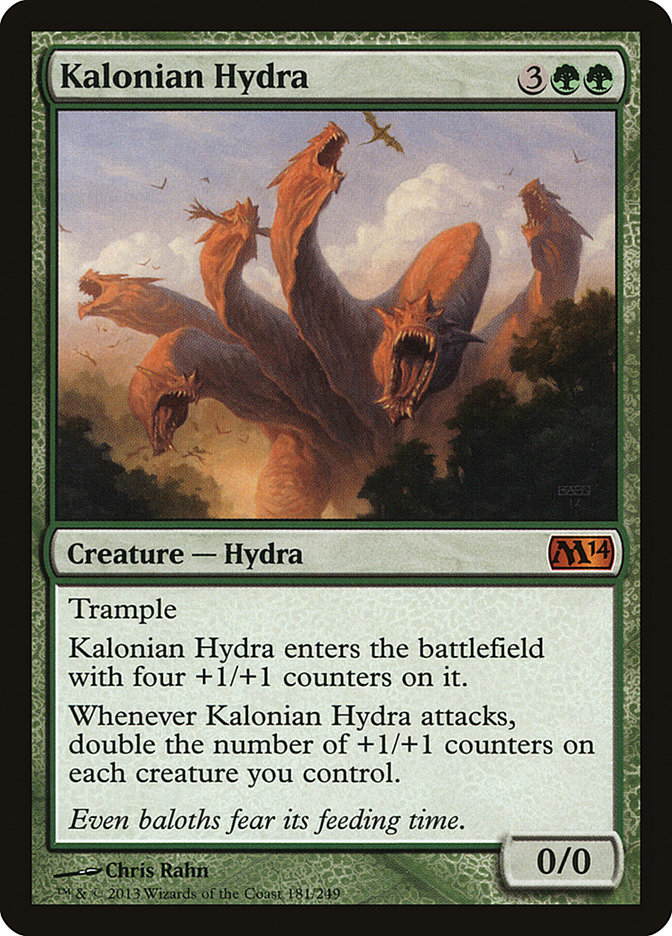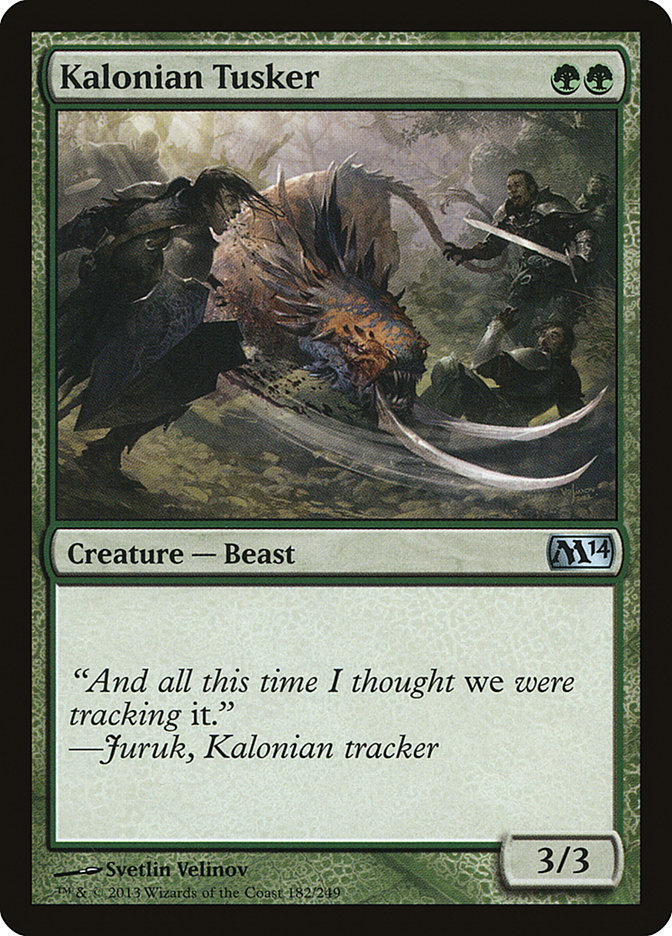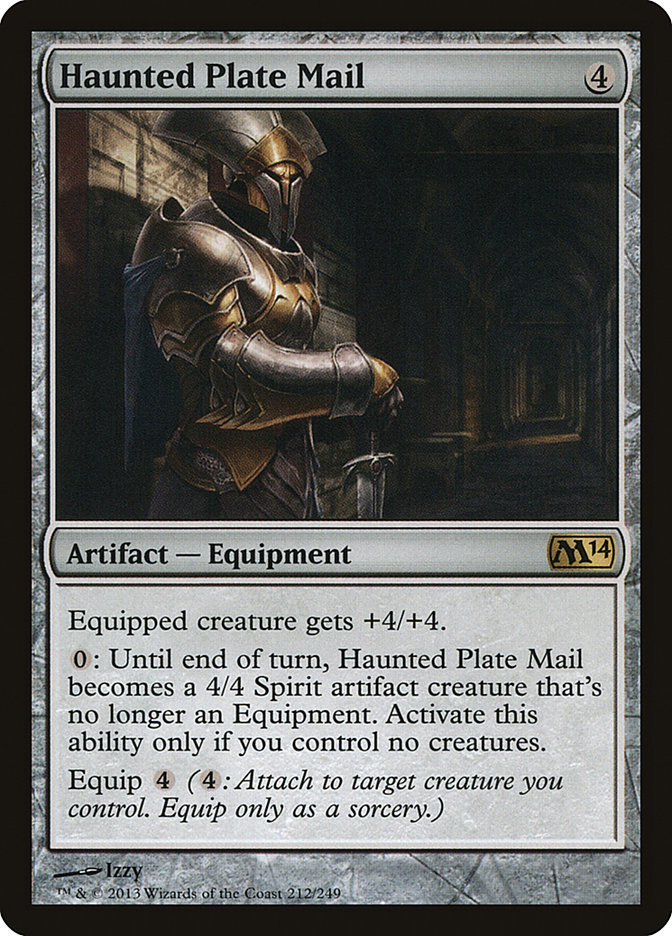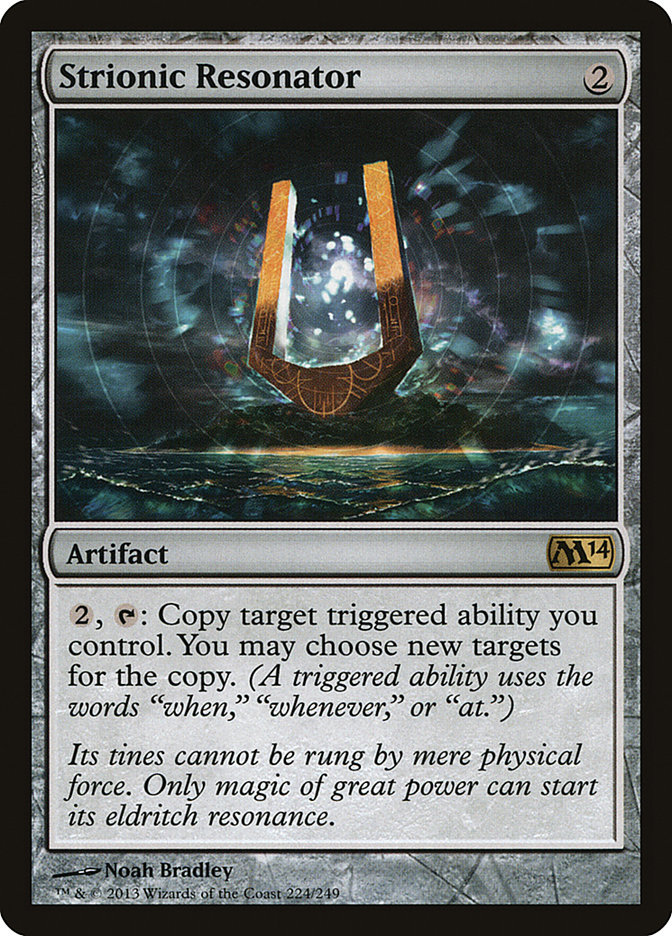With M14 being released this Friday, it’s time to consider the set in the context of Cube.
As Mark Nestico mentioned in an article last week, the set is on the weaker side for core sets. When recording the Third Power podcast review of the set, guest Justin Parnell and I talked about how previous core sets brought Cubes a lot of powerful cards. He compiled the following list:
M10: Harm’s Way, Honor of the Pure, Elite Vanguard, Baneslayer Angel, Doom Blade, Acidic Slime, Great Sable Stag, Borderland Ranger, Gargoyle Castle, Master of the Wild Hunt, the "buddy" lands (Glacial Fortress)
M11: Obstinate Baloth, Stormfront Pegasus, Aether Adept, Fauna Shaman, Sun Titan, Frost Titan, Grave Titan, Inferno Titan, Primeval Titan, Cultivate, Reassembling Skeleton, Preordain
M12: Sphinx of Uthuun; Flames of the Firebrand; Stormblood Berserker; Chandra’s Phoenix; Sublime Archangel; Phantasmal Image; Garruk, Primal Hunter; Grand Abolisher; Rune-Scarred Demon; Garruk’s Companion
M13: Ajani, Caller of the Pride; Disciple of Bolas; Flinthoof Boar; Searing Spear; Thundermaw Hellkite; Thragtusk; Knight of Glory; Knight of Infamy; Augur of Bolas; Yeva, Nature’s Herald; Chandra, the Firebrand
That said, even though there aren’t as many good cards in M14 as in previous core sets, there are still some gems here.
Before talking about the cards in M14, a quick aside about clones/planeswalkers since the new rules come into effect when the set is released. I’ve heard discussion about how people think that clones like Phantasmal Image and Phyrexian Metamorph lose a lot of value since they can’t kill legends anymore. This simply isn’t true. Since the new rules got announced, I’ve been testing the new rules in weekly Cube drafts, and they’ve come up about three times out of however many games. For the most part, killing legends is a corner case and makes up a fraction of the usefulness of those cards. Don’t take them out because you’re scared of them losing value, as they haven’t.
White
Archangel of Thune
Archangel of Thune received a lukewarm reception when it was spoiled, but the card is a solid role filler as a midrange beater. As we’ve learned from cards like Elesh Norn, Grand Cenobite, there tend to be random 1/1s and 2/2s hanging around after they’ve done their thing (like a Aether Adept after bouncing a creature) in the middle stages of the game, and Archangel of Thune can make them sizable threats with a trigger or two. Because of this, I found she had the best experience in decks like Selesnya Midrange that had a lot of those creatures like Wall of Omens, Soldier tokens and mana dorks. She also tends to make attacking for an opponent pretty awkward because even if she ends up dying in combat, her global pump may make such an attack unwise.
One of the things that will keep her from making smaller lists is that she is a bit too low impact for aggressive decks since she can’t win the game immediately after being played, which is what your five-plus-drops should be doing. She doesn’t have an immediate impact on the board like the usual control finishers do. Outside of Baneslayer Angel, Reveillark, and Cloudgoat Ranger (and Gideon Jura if you want to count him as a creature), the five-drop slot for White creatures isn’t filling to the brim as there’s a second tier of creatures like Geist-Honored Monk, Scion of Vitu-Ghazi, and Karmic Guide. Archangel of Thune is going to be on the higher end of the second tier, although awkwardly she combines very well with the former two (a point that Justin Parnell made as well).
Banisher Priest
For aggressive white decks, Banisher Priest is mostly an upgrade over the old Fiend Hunter because of the two power. Fiend Hunter’s 1/3 body was usually pretty mediocre in white aggressive decks because even if it was a body that got rid of an opposing blocker, its one power left a lot to be desired.
There’s the fear of losing out on the "blink" tricks that Fiend Hunter had (removing it with the enters-the-battlefield trigger on the stack) and thinking that Fiend Hunter is much better than Banisher Priest, but there aren’t that many instant-speed bounce tricks in Cube.
For example, the ones that are frequently used in Cube:
Parallax Wave; Capsize; Into the Roil; Venser, Shaper Savant; Cryptic Command; Stonecloaker; Crystal Shard; Erratic Portal; Repulse; Momentary Blink; Waterfront Bouncer
When you think about it, that isn’t really that many cards. It’s similar to when people dismissed Obzedat, Ghost Council because they thought that there were a lot of ways to kill it at instant speed, like Swords to Plowshares but it turned out there aren’t that many.
Banisher Priest also loses out on being able to combine with instant-speed removal to permanently exile something, but I found that was a corner case as well. In the same vein of how the ability to kill legends is lost with Phantasmal Image but it retains most of what made it good, so does Banisher Priest’s exile ability, so don’t get too scared of it (and getting blown out mid-combat, which I found didn’t happen terribly often with Fiend Hunter.)
Banisher Priest can replace Fiend Hunter in Cubes in one of those "easy upgrade" kinds of situations, but both can easily live alongside each other in a Cube because Fiend Hunter’s third toughness makes it better against the aggressive decks that like their fair share of 2/Xs.
Bonescythe Sliver
By itself, Bonescythe Sliver doesn’t really seem to do much; we’ve seen a very similar effect with Kinsbaile Cavalier, which Bonescythe Sliver is a riff on. That said, there’s been discussion about whether Slivers are now worth supporting in Cube.
In short, no.
Most of the tribal cards in Cube need to be good enough on their own, like Siege-Gang Commander and Graveborn Muse, or need to make it so that using your picks on the tribe and places in your deck are worth it. Let’s say that, for example, you draft the following Selesnya Midrange deck (list taken from the Turn One Magic blog, a nice Cube blog that talks about decklists and theory):
Creatures (12)
- 1 Llanowar Elves
- 1 Birds of Paradise
- 1 Fyndhorn Elves
- 1 Phantom Centaur
- 1 Qasali Pridemage
- 1 Acidic Slime
- 1 Baneslayer Angel
- 1 Stoneforge Mystic
- 1 Mirran Crusader
- 1 Primordial Hydra
- 1 Fiend Hunter
- 1 Wolfir Silverheart
Lands (16)
Spells (12)

Take four nonland cards and pretend that they’re replaced with Bonescythe Sliver, Gemhide Sliver, Manaweft Sliver, and Chameleon Colossus. Would this make the deck better? Aside from the argument that the two 1G Slivers may help the deck by being mana producers, it will not. If you put a significant number of Slivers in (requiring you to go extremely deep), it’ll water down the overall Cube sections, making the decks weaker and making the sections that don’t have a lot of Slivers better. Without explicit support, 3W for a 2/2 double striker isn’t worth it, even if it can randomly make other changelings attack for a ton of damage. Besides, white four-drops are among the cream of the crop in Cube, and this can’t stack up even in its best-case pipe dreams.
Fiendslayer Paladin
Fiendslayer Paladin looks to be on the weak side for Cube cards. One of the nicer things about a card like Paladin En-Vec is the ability to get around almost all red and black removal except for edicts. Due to Fiendslayer Paladin’s limited protections, it doesn’t even prevent a lot of the red/black kill spells like untargeted removal and ETB effects (overloaded Mizzium Mortars / Nekrataal). Because of this, it’ll usually play out like an overcosted Knight of Meadowgrain, which is losing favor in Cubes nowadays. It’s arguable about whether it’s an upgrade to Paladin En-Vec because the lifelink would be better versus non R/X and B/X decks, but I’d honestly rather skip both for Cube because of their inefficiency unless you really need Rakdos hosers.
Imposing Sovereign
Blind Obedience is a card that held promise for white aggressive Cube decks, but it ended up getting cut from a lot of lists. Noncreature spells in aggressive decks need to be very high impact, and Blind Obedience ended up being a bit too low impact for those decks.
Exchanging the ability to extort and to Kismet artifacts for a 2/1 is a big upgrade, similarly to how putting a 2/1 body on Thorn of Amethyst made Thalia, Guardian of Thraben Cube worthy (although obviously not quite as big of a jump in power level). Imposing Sovereign is a generally solid card for white aggro decks to keep the pressure on against all types of decks, but it’ll really shine against the green midrange decks that can put up bigger creatures than white aggressive decks as roadblocks. The 1W cost instead of WW cost is excellent since it makes it easy to cast on curve to hose opposing blockers since having that effect in play ASAP is key. A solid addition that is one of my favorites for Cube.
Path of Bravery
Much like how Blind Obedience ended up being too low impact for aggressive decks, so will Path of Bravery. Being an anthem that requires only one white mana is nice over something like Glorious Anthem, but the inconsistency of the card and it being a nombo with cards like Sulfuric Vortex and even fetchlands is a big drag because white aggressive decks won’t have many ways to gain life. Its life gain can help in aggressive mirrors where it’ll mostly be a way to gain life, but even then I’d rather have something like Glorious Anthem most of the time.
Blue
Colossal Whale
We’ve got enough finishers in the six-plus mana range (counting Aetherling as either a six- or seven-drop), and all of the ones available are better than the Whale, which provides no immediate value and doesn’t do that much even if it attacks for a turn or two without dying.
Tidebinder Mage
Tidebinder Mage is objectively one of the better cards of the hoser cycle, but it still isn’t very good even for tempo decks. Unlike cards like Lifebane Zombie, it doesn’t do enough when not against R/X or G/X. Unless you really need to hose those decks and have the room to spare for a card this narrow, it’s an easy pass.
Black
Lifebane Zombie
At first, I dismissed the card as a bad hoser card, but when you think of it as a card like a Dauthi Marauder + cantrip-less Peek, it looks much better. Black three-drops are pretty anemic (the best being Geralf’s Messenger, Hypnotic Specter, Vampire Nighthawk, and Bone Shredder, but the quality drops quickly after that), so the competition is low. Peek abilities are nice in aggressive decks because they give you the ability to play around mass-removal effects, and while it’s awkward that you can’t take those cards out of the opponent’s hand, it’s solid for being able to provide that information to you.
Granted, if you’re able to nab an opposing green or white creature like a Thragtusk, Restoration Angel, or Kitchen Finks, you’re going to be on top of the world, but even if it doesn’t three power of intimidating evasive damage for three is pretty solid for the mana. If the black three-mana creature slot gets better cohorts, Lifebane’s days will be numbered, but it should have no problem fitting into medium-sized (and possibly smaller) Cubes right now.
Liliana’s Reaver
As discussed in Justin Parnell last article, Liliana’s Reaver is one of the better saboteur creatures without evasion because it has decent stats and an insane combat damage trigger that emulates Sword of Body and Mind and Sword of Feast and Famine’s damage. I was initially excited about this creature and tested it in my Cube shortly after it was spoiled, but I found that it was lacking. It’s absurd saboteur trigger rarely triggered because even although deathtouch made people shy away from wanting to block it with larger creatures, it wasn’t the best way to ensure that it connected since it usually traded with either a creature with a similar casting cost or something more expensive or got chump blocked.
Much like the argument against putting Archangel of Thune into a smaller list, I found that it is too low impact as an aggressive curve topper since its positive contribution is mostly dependent on the opponent not having blockers. It was also too low impact for slower black decks. Unlike Archangel of Thune, I ended up disappointed by Liliana’s Reaver.
Shadowborn Demon
Unlike traditional "187" creatures like Nekrataal and Shriekmaw and even others like Predatory Nightstalker, Shadowborn Demon can’t just be jammed into any deck that can reliably cast it. (Running the five-creature Grixis Control special? Sure, get Nekrataal / Shriekmaw in there!) Because of this, I’ve seen people play it in the wrong deck or people just being too scared of the drawback – both resulting in people trying to play it in the wrong deck dismissing it as bad. Instead of thinking of it like a Nekrataal or a Shriekmaw, a better way to think of it is similar to something like a Bone Shredder with a bigger upkeep but with a higher potential upside by making it worse for your opponent to attack (instead of making you not need to pay echo, you eat their largest attacker most likely) and attacking for a lot of evasive damage.
I found that it works quite well in black aggressive decks by providing immediate value and letting you trade your early-game creatures that probably aren’t doing much for five flying damage (and it won’t take more than a few attacks with this guy) because its drawback isn’t that bad there. Decks that have ways to produce tokens or recursive threats (Squee, Goblin Nabob / Bloodghast / Gravecrawler) also had success with Shadowborn Demon. I found that it was difficult to get to the six creatures in the graveyard unless you have a deck that specializes in symmetrical disruption, a la Pox; Braids, Cabal Minion; and Smokestack.
Don’t try to jam Shadowborn Demon into your five-creature Grixis Control deck because you’ll just end up disappointed. If you don’t support black aggressive decks, Shadowborn Demon won’t find its way into your Cube.
Xathrid Necromancer
Xathrid Necromancer is essentially Rotlung Reanimator 2.0 with a more relevant creature type trigger—you won’t find as many Humans in black as you will in white and surprisingly red, so it works well for Rakdos and Orzhov decks. Creatures like Necromancer that work as fodder for sacrifice effects work extremely well with symmetrical disruption / sacrifice effects (like Shadowborn Demon), which also tend to work well in aggressive decks. It’s counterintuitive that a 2B 2/2 with persist would work well in aggressive decks, but it ends up doing so. That said, if I had to choose between Lifebane Zombie and Xathrid Necromancer, I’d probably go with the Zombie, but I think that the Necromancer should find a home in Cubes due to its ability to work well in symmetrical-sacrifice decks.
Red
Awaken the Ancient
In previous articles, I talked about how crowded the four-drop slot is in Cubes and how red has recently gotten solid ones like Hellrider and Hero of Oxid Ridge to serve as curve toppers for aggressive decks. The previously anemic five-drop slot also has been getting some attention with cards like Thundermaw Hellkite and Zealous Conscripts. Awaken the Ancient falls in the category of being a five-drop since it requires 1RRR to cast and another to use to attack with the creature. And since it uses that Mountain, it virtually has an upkeep cost of R.
The lack of evasion is also incredibly awkward on such a mana-intensive creature, and even the deck that can realistically play it on curve—Mono-Red—will want little to do with it due to its lack of evasion and immediate board impact.
Chandra, Pyromaster
Chandra, Pyromaster feels like it’s underrated, but it’s a solid addition to red-based aggressive decks. Unlike a lot of existing red fours, it doesn’t deal as much with pure damage-to-mana as it does by helping red decks’ attackers get through larger creatures that get in the way (in a similar fashion to Imposing Sovereign) and then in subsequent turns helping you draw more direct damage through its middle ability, which in an aggressive deck shouldn’t be hitting blanks. It’s also nice because if you get another untap with her and can’t close out the game with her +1 because your opponent has a bunch of green 4/4s blocking your team, the 0 ability helps you to go over the top of their beasties and draws you more direct damage.
It’s weaker in slower red decks like Jund since the +1 ability loses a lot of value and the ability to miss on the 0 ability skyrockets. That said, for its role in aggressive decks as a way to close the game out and allow you to keep up in scenarios when you can’t close out, I think it’ll be a solid role filler.
Mindsparker
Red’s entry into the hoser cycle is mainly a 3/2 first striker for 1RR, which is a pretty decent deal for the stats, with some flavor text about affecting white and blue instants. Aside from Countryside Crusher and arguably Chandra’s Phoenix, for such an aggressive and combat-oriented color red’s threes aren’t the strongest fighters (Manic Vandal, Imperial Recruiter, and Squee aren’t the best fighters, as good as they are); Mindsparker brings a nice addition to that category. I find that R/X aggressive decks tend to lean on three-mana creatures in other colors, so this helps in that regard, but like with Lifebane Zombie a few more combat-oriented three drops in red will make Mindsparker’s days numbered. It may last longer if you feel your R/X decks need additional game against blue control decks.
Ogre Battledriver
Ogre Battledriver would’ve been a shoe in for Cubes years ago but has lost out due to the aforementioned competition. There’s a case for having room for it in larger Cubes in a similar fashion as Urabrask the Hidden—as a creature that makes the subsequent creatures much scarier—but even still that’s pretty dubious because you don’t tend to see creatures like Urabrask nowadays and non-aggro red cards tend to take the form of spells like Earthquake / Wildfire / Sneak Attack than midrange creatures like Urabrask and Ogre Battledriver.
Young Pyromancer
Shockingly, Young Pyromancer isn’t as insane as you would think in Cube. I can’t speak for how it’ll be in Constructed, but in my experience in Cube Young Pyromancer is quite a ways from the Stoneforge Mystic, Tarmogoyf, Snapcaster Mage, and Dark Confidant "cycle." Ignoring that high caliber, it’s a solid creature. I found that its best home is in burn-heavy mostly-red decks since it lets your spells give you extra bodies to swarm your opponent and, unlike Guttersnipe, does so while being an on-curve creature.
In aggressive decks that focus on equipment, planeswalkers, and creatures that emulate spells (Flametongue Kavu), I found that its impact is low because it’s hard to get two triggers and there were times when the Elemental tokens didn’t really do much aside from acting as Greater Gargadon fodder. In those decks with lower spell counts, I actually would have preferred something with higher board impact like Gore-House Chainwalker, as surprising as that may sound.
However, it worked surprisingly well in non-aggro decks like Jund, Counter Burn, and Grixis because the Elemental tokens worked well with the game plan of stalling out and going over the top. All in all, I found that it was a solid creature but nothing too insane.
Green
Elvish Mystic
Elvish Mystic is an extremely easy inclusion for Cubes and by far the one that I can see going into the most Cubes once the dust settles. I’ve heard some people say that they are going to take Fyndhorn Elves out for this guy because of art, but when has art had anything to do with serious Cube design? It just seems like a copout because there are few green decks that wouldn’t want to utilize another mana dorks— those being decks that can’t reliably cast it in the early stages of the game. It’s an easy upgrade from filler mana dorks like Boreal Druid, but it’s powerful enough to be worth it even if it feels like there’s a saturation of mana dorks your Cube. You should play to that strength in green, not shy away from it.
Garruk, Caller of Beasts
Like Chandra, the new Garruk feels underrated, but it’s a nice addition to green even if it’s the worst Garruk. In testing, I found that if it isn’t in immediate danger of dying after being cast; it typically paid off because its +1 ability can help you run away with the game by drawing multiple creatures a turn, similarly to how a card like Domri Rade can reward creature-heavy midrange decks in Cube.
There’s the argument about how there aren’t many ways to "go big" with the middle ability by getting something that costs more than six mana out with Garruk, but I found that you didn’t really need to do so; getting a mid-sized threat that can protect Garruk followed by it drawing creatures was typically a way to ensure getting a lot of advantage. It’s also interesting that the +1 and -3 abilities feed into each other very well and can make it so that after +1ing you can -3 to help to vomit your hand out. That said, planeswalkers that can’t defend themselves don’t tend to last very long in Cube. Although it usually isn’t difficult to run something like a Wall of Roots / Wall of Blossoms out to defend it, there were times when it couldn’t be cast because it’d die to the board state.
Because of this, out of Primeval Titan, Rampaging Baloths, and Garruk, Caller of Beasts (the six-mana green cards in my Cube), new Garruk is the weakest, and because of that I can see his lifespan being short in my Cube. So I don’t give it a high amount of praise, but it’s better than people think.
Kalonian Hydra
Kalonian Hydra is big and dumb, but it’s extremely good at being big and dumb by being a virtual 8/8 for 3GG with the ability to close out games extremely quickly. Most Cube-worthy big creatures don’t tend to do very well unless they have some sort of incidental value (which you could argue that Wolfir Silverheart has). Kalonian Hydra doesn’t do very well on the old "Vindicate test," but it closes out games so quickly that it’s usually still worth taking that chance since two hits usually is game over. Much like with Wolfir Silverheart, cheap removal can make Kalonian Hydra look abysmal, but I found that the opponent had to draw a removal spell in short order or died quickly.
Its +1/+1 counter ability, like Archangel of Thune’s life gain +1/+1 counter ability, is mostly just gravy but combines with a few cards that make it into the green midrange decks that will use Kalonian Hydra. Even if it doesn’t perform as well against removal, Kalonian Hydra should be an easy exchange for cards like Vorapede or even something like Genesis.
Kalonian Tusker
Kalonian Tusker is nice if you support non-ramp decks in green but a bit too low impact if you don’t because even if the GG mana cost for a 3/3 is incredibly efficient, its body may be too small for the slower green decks like Jund, Junk, and Naya. It’s true that Watchwolf hasn’t made Cubes in years, but the overall competition in green isn’t as high in the smaller and tighter competition in G/W. For Cubes that do support green aggro, Kalonian Tusker is a big upgrade over Garruk’s Companion because even though it’s worse with cards like the Swords, it’s better overall since it survives fights against 2/Xs, which there tends to be a lot of in Cube (especially in aggressive mirrors).
Miscellaneous
Haunted Plate Mail
Haunted Plate Mail has brilliant design, but it’ll be on the outside looking in for Cube. The decks that I can see using this best are decks like Wildfire for being a "creature" that lives through Wildfire and in a pinch equips to other creatures to help them do so, albeit at an incredibly inefficient rate. Haunted Plate Mail isn’t really worth the mana cost and worth tapping out for in slower decks, especially the low-creature decks that hope to emulate the draw-go decks that employed Stalking Stones and Steel Golem years ago. When I tested it, it didn’t make very high of an impact since even the blue control decks didn’t want it. It’s unfortunate, but Haunted Plate Mail doesn’t look to be very Cube worthy.
Strionic Resonator
Similarly to Haunted Plate Mail, Strionic Resonator is a card that seems to cost too much mana and too little impact to be worth using. It offers a one-mana discount on Rings of Brighthearth, but it still requires too much mana. The best use of it is in midrange creature decks that are heavy on enters-the-battlefield triggers, like a Cube deck that can use Birthing Pod. However, unlike Birthing Pod, Strionic Resonator will require too many cards that trigger it to be worthwhile.
I hope that this article has given you some insight into what M14 offers for your Cube. It isn’t as exciting as previous core sets with Thragtusk, Phantasmal Image, and Baneslayer Angel, but we still get a few nice tools to play with.
May all of your opening packs contain Sol Rings!
@UsmanTheRad on Twitter
My blog featuring my powered and pauper Cube lists: I’d Rather Be Cubing
Cube podcast that I and Anthony Avitollo co-host: The Third Power

